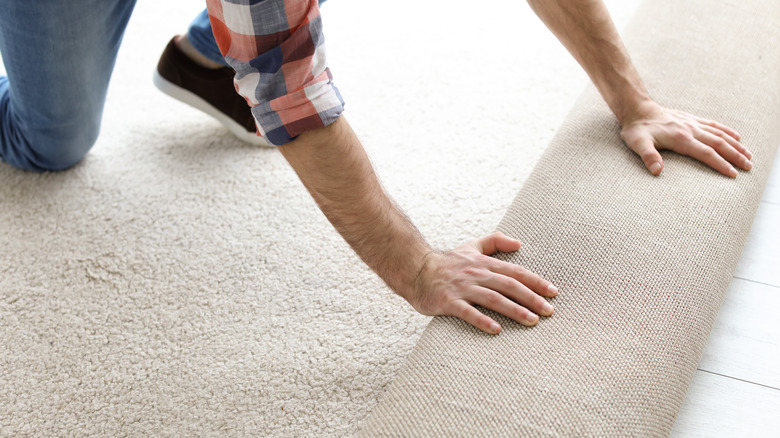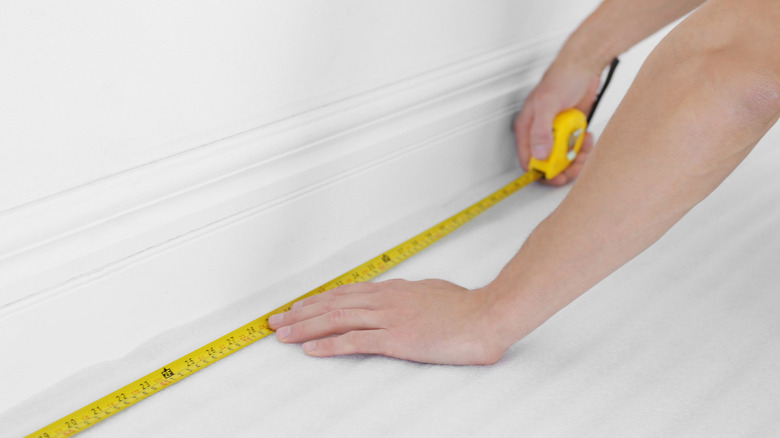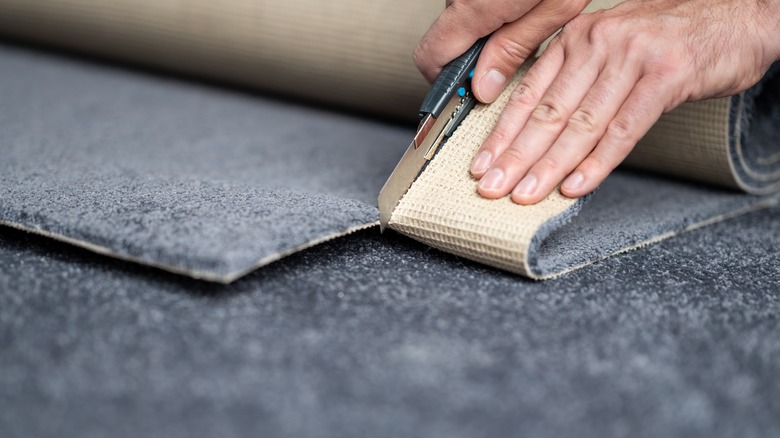Here's How To Easily Install Carpet At Home
Fed up with that old, worn-out floor, longing for a makeover that will infuse your space with vitality? Imagine stepping into a room that envelopes you with warmth and comfort, thanks to a plush carpet caressing your soles. Don't daydream anymore. With a dash of elbow grease, heaps of determination, and proper tools and materials, turning that fantasy into a reality for your home couldn't be easier. Kick off the installation by prepping the subfloor, then secure the underlay and carpet. A few touches and tweaks guarantee your new floor covering looks stunning and fits snugly.
Learning how to install a carpet yourself is a gratifying adventure. But we still can't underestimate the thrill of saving those precious dollars. Consider that professional installation can set you back anywhere from $0.50 to $1 per square foot for labor alone. And that's not even including additional expenses like carpet removal, subfloor repair, and moving furniture. By embarking on this DIY adventure, you won't just save money on carpeting. Picture the awe-struck faces of your guests and friends as you regale them with how you single-handedly transformed your living space into a plush paradise — trust us, your prowess will floor them.
Preparing for a carpet installation at home
Picture yourself armed with a tape measure, hammer, utility knife, chalk line, knee-kicker, carpet stretcher, duct tape, gloves, a carpet tucker, tack strips (carpet grippers), and hammer tacker. But beware that some tools needed to install a carpet, including a knee kicker, power stretcher, and seam iron, can dent your wallet. The good news is that you can hire them affordably at rental yards or a nearby Home Depot tool rental center. Quality carpet padding is essential for a luxurious underfoot experience, superior soundproofing and heat insulation, and a prolonged rug life. With your supplies sorted, channel your inner interior designer and select a carpet type and style that match your aesthetics and budget.
Next, determine your room's length and width, accounting for hidden sections like closets and pantries. Let not oddly shaped spaces scare you; simply divide them into smaller rectangles, squares, and other easily manageable shapes. Calculate the total square footage of your new carpet kingdom by combining the surface areas of these sections. Add an extra 10% to the figure as a precaution. You can now procure a carpet, padding, and tack strips suited to your dimensions. You also want to prepare the battlefield for your DIY carpet installation. Remove any timeworn linoleum or hardwood, then spruce up the subfloor for its new cloak. Finally, vacuum and damp mop the surface to banish dirt — that notorious moisture magnet and breeding ground for mold.
The process of laying a carpet yourself
Begin by installing the tack strips along the room's perimeter, leaving a tiny gap between them and the wall. This space will allow you to tuck the carpet edge under the baseboard. Pins should face the wall for a secure grip on the carpet. Use the hammer cheek or enlist the rubber mallet and nail bar duo to install the grippers on hard-to-reach or height-limited spots. Next, the underlay. Spread it over the subfloor, covering the entire area within the carpet grippers. Use a hammer tacker to staple the padding to the subfloor (or glue if you have a concrete floor), duct tape to secure the joints, and a utility knife to trim excess padding. Unroll the rug, ensuring it covers the room and spills over the tack strips. Relief cuts come in handy for a perfect fit at the corners and around pipes. Afterward, use the binding tape-seaming iron-carpet roller trio to secure the seaming tape beneath the joints with the adhesive side up in low-traffic spots.
As for how to install a carpet without a stretcher, use a knee-kicker to achieve a smooth, wrinkle-free fit in small spaces. A stretcher will, however, suffice for broader rooms. Done with the placement, trim away any excess material, then tuck the rug under the baseboard using a carpet tucker. Finally, install the doorway transition strips and let the new floor covering air out (and acclimate) for 24 hours before introducing furniture.


